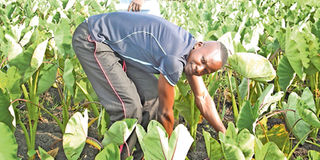Conserve cultivars to increase ‘nduma’ yields

A farmer tends arrowroots in a farm. The plant is a good source of starch, vitamins A, B, C, folic acid and riboflavin as well as protein, dietary fibre, sugar and minerals. FILE PHOTO | NATION MEDIA GROUP
What you need to know:
- Arrowroot can play a big role in fighting hunger as an alternative crop in swampy areas when rice production drops.
- Arrowroot cultivars are currently maintained by local farmers in mixed populations. Farmers largely select cultivars based on taste, yield, root colour and size of the plant.
- Researchers then get these materials for improvement. Improving yield and mass production of arrowroot requires heavy involvement of experienced farmers.
- These centres could be farmer fields, community fields or research stations where farmers can access planting materials and get skills.
Arrowroot, commonly known as nduma, is a perennial root crop which grows in marshy areas, taking six to nine months to mature.
The crop is tasty and its corms (swollen underground storage stems) are usually baked, roasted or boiled while its leaves are used as vegetables.
Nduma is a good source of starch, vitamins A, B, C, folic acid and riboflavin. It is also modest in protein, dietary fibre, sugar and minerals.
Arrowroot is propagated vegetatively using suckers, whole corms or cormels and yields 12-25 tonnes per hectare.
It is grown in central, western and coastal Kenya. The crop shares similar cultivation practices with rice but has low input needs with no known serious pests and diseases.
Arrowroot can play a big role in fighting hunger as an alternative crop in swampy areas when rice production drops.
Despite its importance, getting nduma cultivars is challenging, especially to new farmers. Differentiating edible arrowroot from its wild relative is a tough task for the farmer.
Arrowroot lags behind in mass cultivar maintenance, development and improvement compared to other vegetatively propagated root crops like cassava and sweet potato. No wonder it is referred to as an “orphan” crop.
Arrowroot cultivars are currently maintained by local farmers in mixed populations. Farmers largely select cultivars based on taste, yield, root colour and size of the plant. They discard the poor ones, leading to the erosion of key genetic traits.
Arrowroot suckers are bulky and not easy to transport over long distances. They also easily lose moisture, leading to low germination rates.
INVOLVEMENT OF EXPERIENCED FARMERS
Genebanks face a challenge in conservation of landraces collected from vegetative materials. This is confounded by the ecological disparity between conservation centres and collection sources, making it hard to propagate some cultivars.
In addition, vegetative materials are usually conserved in a growing stand, which makes the operation expensive compared to in situ conservation or seed crops which are often preserved in sealed air-tight containers in refrigerators.
The Muguga-based National Genebank of Kenya does the collection, conservation, multiplication and characterisation of seed crop and forage gene resources threatened by genetic erosion.
Researchers then get these materials for improvement. Improving yield and mass production of arrowroot requires heavy involvement of experienced farmers.
Arrowroot in situ cultivar conservation and improvement centres can be established at the national, regional, county and divisional levels.
These centres could be farmer fields, community fields or research stations where farmers can access planting materials and get skills.
This would lead to propagation of uniform cultivars, resulting in similar taste and good harvests with a huge possibility of tracking production trends.
Lastly, there should be established national, regional or local frameworks including organisations dedicated to the collection, conservation and improvement of the arrowroot.
The centres will facilitate material transfer between regions and ensure value-addition to the harvested crop for markets in and outside the country.
Mr Wesonga teaches at the University of Helsinki




